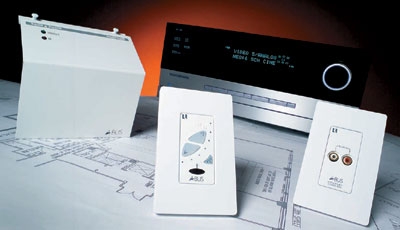Music Around the House Page 2
LeisureTech Electronics in Sydney, Australia, invented the A-Bus system in 1997 and now licenses the technology to many companies. An A-Bus system can be configured in a variety of ways and mix or match parts from different manufacturers. 
In a typical A-Bus system, source components in the main room connect to a hub, which in turn connects to the keypads. The pads include amplification for the speakers in each room and allow you to adjust the volume or turn the music on or off. Each hub can drive from two to six keypads, and hubs can be linked together to create a virtually unlimited system.
I set up two separate configurations. The first used the A-Bus outputs from a Harman Kardon AVR 7300 receiver (rear in photo above). Source components and A-Bus key-pads - in this case Russound A-KP2s (center, $189 each) - were connected to the receiver, which can drive two keypads. To add additional pads, I used a Honeywell MDADZ600 six-zone/one-source hub (left, $275). This configuration offers a simple path to housewide audio but provides only a single source to every zone. For true multi-zone/multisource function, my second setup replaced the Honeywell hub with a Russound AH-484 four-zone/four-source hub (not shown, $599), which requires a 24-volt, regulated power supply ($139). The receiver could still be used as one of the sources.
are basically small amplifiers with a volume control and a built-in infrared receiver. Russound's stylish A-KP2 has a power button and a green backlight, and it displays your volume setting with an array of green LEDs. The power button can turn just that zone off, or it can turn the whole system off if pressed and held. Tapped lightly, it toggles between remote sources in multisource systems. (A Single/Multi switch, not visible in photo, enables this function.) Russound smartly provides line-level outputs so you can add a powered subwoofer to your speakers or use a more powerful external amplifier to drive them.
To add a local source, like an MP3 player or a TV, you'll need a local-source module like Russound's A-LC2 (right in photo, $129). The A-LC2 automatically overrides whatever's coming from the main system when it senses a signal. So if you want to listen to your bedroom TV over your A-Bus-connected speakers, just turn the set on.
was easy. I ran Category-5 (Cat-5) wire from the hub to each keypad and speaker wire from each keypad to the speakers in that room (zone). If I'd been using a local-source module, I'd have run Cat-5 from the hub to the module, then from the module to the keypad - local sources would connect directly to the module. Do-it-yourselfers should have no problem installing this sort of system.
is nonexistent for an A-Bus system since most keypads offer only volume control. Even the A-KP2 pad provides only rudimentary source selection.
Other than the local-source module and the variety of hubs, there aren't many options. You could add paging or remote doorbell chimes using add-on modules, however.
The system definitely played louder than its rated 7.5 watts per channel would suggest, and it should fill most rooms with background music. But if you want bass, you'll need to add a powered subwoofer. The A-Bus output from the Harman Kardon receiver overdrove the keypad amps, producing distortion, but a replacement sample of the receiver from a later production run sounded fine. (Early AVR 7300s will be fixed at no charge under warranty.) The Russound hub, connected to the source components, produced good sound from the get-go and allowed for a more versatile setup. PDF: Fast Facts
- Log in or register to post comments



































































